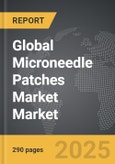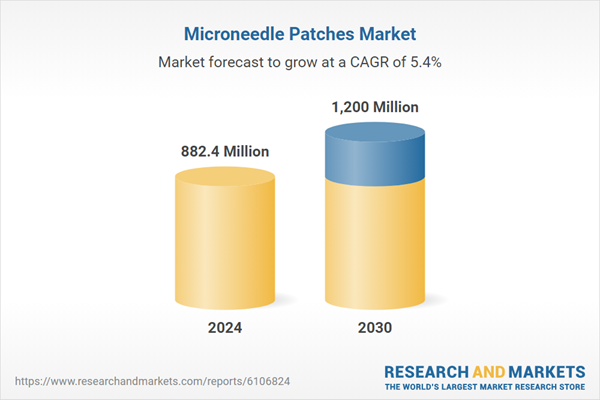Global Microneedle Patches Market - Key Trends & Drivers Summarized
How Are Microneedle Patches Transforming Drug Delivery and Skincare Technologies?
Microneedle patches are rapidly transforming the landscape of drug delivery and skincare by offering a minimally invasive, painless, and efficient method of administering active compounds through the skin. These patches consist of arrays of microscopic needles that create tiny channels in the outer layer of the skin, allowing for the direct and controlled delivery of drugs, vaccines, or cosmetic ingredients into the dermis. Unlike traditional hypodermic needles, microneedles are designed to be virtually painless, making them especially appealing for pediatric, geriatric, and needle-phobic populations. The patches can be made from biocompatible polymers, silicon, or metals and can either dissolve in the skin or remain intact depending on the therapeutic goal. This technology has demonstrated strong potential in the delivery of insulin, cancer drugs, hormones, and vaccines, as well as in cosmetic applications like anti-aging treatments and acne management. In skincare, microneedle patches are enabling enhanced penetration of hyaluronic acid, peptides, and vitamins, offering visible improvements in skin tone, texture, and hydration. Furthermore, the ease of self-administration makes these patches an ideal solution for home-based care, reducing the need for clinical visits and improving treatment adherence. As global health systems push for more accessible, personalized, and user-friendly treatment options, microneedle patches offer a versatile platform that bridges pharmaceutical science and consumer wellness. Their compact design and long shelf-life also make them suitable for use in remote or resource-limited settings where refrigeration or trained personnel may not be available. With continued innovation in materials and manufacturing processes, microneedle patches are expected to become a mainstay in both medical and cosmetic product portfolios.Why Is the Push for Painless, Convenient Delivery Methods Fueling Market Adoption?
The growing demand for painless and convenient drug and skincare delivery methods is significantly fueling the adoption of microneedle patches across both medical and cosmetic sectors. Consumers and patients increasingly seek treatments that minimize discomfort, are easy to use, and do not disrupt their daily routines. Traditional injection-based therapies can cause anxiety, pain, and complications such as infections or bruising, deterring some individuals from adhering to prescribed regimens. Microneedle patches eliminate these concerns by offering a virtually pain-free experience, requiring no specialized training to administer and posing minimal risk of complications. Their convenience makes them highly attractive for chronic conditions requiring regular dosing, such as diabetes, hormone replacement, or migraines. In the realm of cosmetics, consumers are gravitating toward non-invasive alternatives that deliver professional-grade results without the need for expensive or time-consuming in-office treatments. The rise of at-home beauty and wellness devices during the COVID-19 pandemic further amplified this shift, creating lasting consumer interest in high-performance, self-care tools like microneedle patches. As global lifestyles become more mobile and health-conscious, products that support discreet and on-the-go use are becoming increasingly desirable. Additionally, the ability to design patches for time-controlled release or targeted delivery enhances their clinical utility by improving pharmacokinetics and reducing systemic side effects. For manufacturers, the scalability and ease of packaging of microneedle patches provide advantages in terms of logistics and distribution. This growing emphasis on user experience, coupled with proven performance benefits, is making microneedle patches a preferred modality for next-generation healthcare and skincare solutions.How Are Technological Advances Expanding the Capabilities of Microneedle Patch Systems?
Technological innovation is rapidly expanding the capabilities of microneedle patch systems, enabling a wider range of applications, improved efficacy, and increased customization. Developments in microfabrication techniques such as laser cutting, lithography, and 3D printing have allowed for precise control over needle geometry, size, and density, which directly influence how substances are delivered into the skin. These advances make it possible to tailor microneedle arrays to specific treatment requirements, ensuring consistent performance across diverse user profiles. Materials science is also playing a crucial role, with new biodegradable and dissolvable polymers allowing for fully absorbable microneedles that eliminate the need for patch removal and reduce waste. Smart microneedles embedded with sensors or responsive materials can now deliver drugs in response to physiological cues like temperature, pH, or glucose levels, enabling real-time adaptive therapies. This is particularly promising in managing chronic diseases, where timely and individualized dosing can significantly improve outcomes. Integration with wearable devices and mobile apps is being explored to track patch usage, monitor patient compliance, and provide feedback to both users and healthcare providers. In cosmetic applications, the inclusion of nanocarriers or encapsulated actives within microneedles is enabling the delivery of otherwise unstable or poorly absorbed compounds. Furthermore, patches are being designed to penetrate different skin depths, making them suitable for applications ranging from transdermal drug delivery to intradermal vaccinations. Technological refinement is also reducing manufacturing costs and increasing production scalability, making microneedle patches more accessible to a broader market. These technological strides are transforming microneedles from a niche innovation into a foundational platform for future therapeutic and cosmetic advancements.What Are the Main Factors Driving Global Growth in the Microneedle Patches Market?
The growth in the microneedle patches market is driven by several key factors, including the rising prevalence of chronic diseases, the increasing demand for minimally invasive treatments, and the global shift toward home-based care solutions. One of the most important drivers is the growing burden of non-communicable diseases such as diabetes, cardiovascular conditions, and autoimmune disorders, which require long-term medication adherence. Microneedle patches offer a patient-friendly alternative that enhances compliance and improves quality of life. In parallel, the cosmetic industry is experiencing a boom in demand for non-invasive, science-driven skincare solutions, with microneedle patches emerging as a premium product category that aligns with clean beauty and at-home treatment trends. Regulatory bodies are also beginning to recognize and support the potential of microneedle systems, with several clinical trials and product approvals signaling growing confidence in their safety and efficacy. Advances in manufacturing and material science are lowering production costs and increasing scalability, making the technology viable for both developed and emerging markets. Strategic partnerships between pharmaceutical companies, cosmetic brands, and technology firms are accelerating product development and expanding distribution networks. Public health initiatives aimed at improving vaccination rates and reducing dependency on cold chain logistics are also spotlighting microneedle patches as an innovative solution for widespread immunization, particularly in remote or underserved areas. Rising awareness, supported by digital marketing, educational campaigns, and influencer endorsements, is further fueling consumer interest. Together, these factors are creating a favorable environment for sustained growth in the microneedle patches market, positioning the technology at the intersection of healthcare innovation, consumer empowerment, and global wellness trends.Report Scope
The report analyzes the Microneedle Patches market, presented in terms of market value (US$). The analysis covers the key segments and geographic regions outlined below:- Segments: Product (Solid Microneedles, Hollow Microneedles, Dissolving Microneedles, Coated Microneedles); End-Use (Hospitals End-Use, Ambulatory Surgery Centers End-Use, Specialty Clinics End-Use, Academic Institutions End-Use, Research Institutes End-Use).
- Geographic Regions/Countries: World; United States; Canada; Japan; China; Europe (France; Germany; Italy; United Kingdom; Spain; Russia; and Rest of Europe); Asia-Pacific (Australia; India; South Korea; and Rest of Asia-Pacific); Latin America (Argentina; Brazil; Mexico; and Rest of Latin America); Middle East (Iran; Israel; Saudi Arabia; United Arab Emirates; and Rest of Middle East); and Africa.
Key Insights:
- Market Growth: Understand the significant growth trajectory of the Solid Microneedles segment, which is expected to reach US$488.1 Million by 2030 with a CAGR of a 7.2%. The Hollow Microneedles segment is also set to grow at 4.1% CAGR over the analysis period.
- Regional Analysis: Gain insights into the U.S. market, valued at $240.4 Million in 2024, and China, forecasted to grow at an impressive 8.9% CAGR to reach $247.6 Million by 2030. Discover growth trends in other key regions, including Japan, Canada, Germany, and the Asia-Pacific.
Why You Should Buy This Report:
- Detailed Market Analysis: Access a thorough analysis of the Global Microneedle Patches Market, covering all major geographic regions and market segments.
- Competitive Insights: Get an overview of the competitive landscape, including the market presence of major players across different geographies.
- Future Trends and Drivers: Understand the key trends and drivers shaping the future of the Global Microneedle Patches Market.
- Actionable Insights: Benefit from actionable insights that can help you identify new revenue opportunities and make strategic business decisions.
Key Questions Answered:
- How is the Global Microneedle Patches Market expected to evolve by 2030?
- What are the main drivers and restraints affecting the market?
- Which market segments will grow the most over the forecast period?
- How will market shares for different regions and segments change by 2030?
- Who are the leading players in the market, and what are their prospects?
Report Features:
- Comprehensive Market Data: Independent analysis of annual sales and market forecasts in US$ Million from 2024 to 2030.
- In-Depth Regional Analysis: Detailed insights into key markets, including the U.S., China, Japan, Canada, Europe, Asia-Pacific, Latin America, Middle East, and Africa.
- Company Profiles: Coverage of players such as AOBiome, Beekman 1802, Bioneutra, Biomilk Skincare, Codex Labs and more.
- Complimentary Updates: Receive free report updates for one year to keep you informed of the latest market developments.
Some of the 44 companies featured in this Microneedle Patches market report include:
- 3M Company
- AVITA Medical
- Becton, Dickinson and Co. (BD)
- BioSerenity
- CosMED Pharmaceutical Co., Ltd
- Debiotech SA
- DermaRoller GmbH
- EnsBio
- Innoture
- Lohmann Therapie-Systeme AG
- LTS Health
- Micropoint Technologies
- Micron Biomedical
- NanoPass Technologies Ltd.
- Nitto Denko Corporation
- QuadMedicine
- Raphas Co., Ltd.
- SNvia Co., Ltd.
- TheraJect Inc.
- Vaxess Technologies
This edition integrates the latest global trade and economic shifts into comprehensive market analysis. Key updates include:
- Tariff and Trade Impact: Insights into global tariff negotiations across 180+ countries, with analysis of supply chain turbulence, sourcing disruptions, and geographic realignment. Special focus on 2025 as a pivotal year for trade tensions, including updated perspectives on the Trump-era tariffs.
- Adjusted Forecasts and Analytics: Revised global and regional market forecasts through 2030, incorporating tariff effects, economic uncertainty, and structural changes in globalization. Includes historical analysis from 2015 to 2023.
- Strategic Market Dynamics: Evaluation of revised market prospects, regional outlooks, and key economic indicators such as population and urbanization trends.
- Innovation & Technology Trends: Latest developments in product and process innovation, emerging technologies, and key industry drivers shaping the competitive landscape.
- Competitive Intelligence: Updated global market share estimates for 2025, competitive positioning of major players (Strong/Active/Niche/Trivial), and refined focus on leading global brands and core players.
- Expert Insight & Commentary: Strategic analysis from economists, trade experts, and domain specialists to contextualize market shifts and identify emerging opportunities.
Table of Contents
Companies Mentioned (Partial List)
A selection of companies mentioned in this report includes, but is not limited to:
- 3M Company
- AVITA Medical
- Becton, Dickinson and Co. (BD)
- BioSerenity
- CosMED Pharmaceutical Co., Ltd
- Debiotech SA
- DermaRoller GmbH
- EnsBio
- Innoture
- Lohmann Therapie-Systeme AG
- LTS Health
- Micropoint Technologies
- Micron Biomedical
- NanoPass Technologies Ltd.
- Nitto Denko Corporation
- QuadMedicine
- Raphas Co., Ltd.
- SNvia Co., Ltd.
- TheraJect Inc.
- Vaxess Technologies
Table Information
| Report Attribute | Details |
|---|---|
| No. of Pages | 290 |
| Published | November 2025 |
| Forecast Period | 2024 - 2030 |
| Estimated Market Value ( USD | $ 882.4 Million |
| Forecasted Market Value ( USD | $ 1200 Million |
| Compound Annual Growth Rate | 5.4% |
| Regions Covered | Global |









